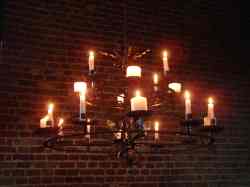| IRON
WORK WITH “EARLY OAK” A great deal of the work of early carpenters
and joiners necessitated products from the blacksmiths forge: hinges,
locks, reinforcing straps, hasps, nails, casement frames, spring latches,
stays, handles, door latches, hanging rails and rings; to name but a
few. There were also items to stand on, or near, and even driven into
furniture, such as candle and rushlight holders.
Today we, as contemporary joiners and carpenters, rely on the blacksmith
just as much and for our top end pieces are extremely particular that
the work is carried out in the same manner as centuries ago. For example,
we mostly use genuine wrought iron (not mild steel or black iron), which
must be shaped on the forge, hand filed and with all the joints fire
welded or hot riveted (no gas or electric welding). Furthermore, no
two nails on our work are exactly identical. Each nail, and there maybe
hundreds in one piece of furniture, is individually worked.
These pages show a cross section of how the blacksmiths art is still
used on our oak furniture and architectural woodwork, either as a necessary
part of its structure and usage, or simply as a means of associated
ornament. |










